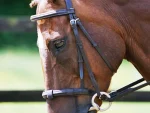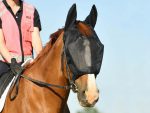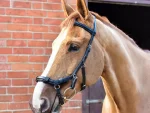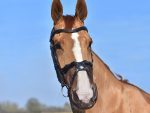1 year product guarantee
Free delivery on most orders over £40
Rated 4.9/5 stars on Feefo

Researched & tested products

Innovating for over 20 years!
Supporting Redwings Horse Sanctuary & Brooke
Feefo Gold Trusted Service Award Winner
Get more time to pay with Klarna
What is Headshaking?
Headshaking explained
Maybe you’re just getting to grips with a new mount this spring or you’re bringing on your youngster. Imagine your horror when you find your horse starts headshaking. Your dreams of being able to compete or even hack safely begin to crumble around you. But don’t despair – headshaking need not mean the end to your horse’s riding career. New research is helping vets and owners to better understand this condition and give practical solutions for managing the problem.
What is headshaking?
Nowadays it seems that everyone knows someone with a head shaker. But what is a ‘head shaker’ and what distinguishes them from a horse with a short-term irritation or behavioural problem?
Most horses shake their heads from time to time to get rid of flies or when frustrated. Horses that simply nod their heads when stabled or as they turn home from a ride, may not be head shakers but ‘nodders’, a condition that is responsive to changes in management. ‘Nodders’ do not usually cause great problems to themselves or their owner. True head shakers do so persistently and for no apparent reason.
They exhibit sharp, jerky vertical and horizontal head movements. The severity of the movements can vary from small flicks to huge, sweeping arcs which threaten to hit the rider on the nose or unseat them. Experts now recognise that head shakers also exhibit symptoms that suggest the horse is suffering from irritation within or around the face and muzzle. Head shakers that also snort excessively during an attack will try to rub their face or act as if a bee has gone up their nose. They may even run their nose along the ground or strike the ground during the attack. Moreover the unpredictability of the length and occurrence of these attacks can severely limit a rider’s ability to compete or even ride safely.
By Dr Katy Taylor De Montfort University
Category
Equine Ailments, Headshaking, WellbeingRelated Articles
View all articlesHead shaking – here’s a little hope!
Read articleRelated Products
View all products-
 Net Relief Muzzle Net£24.99 View product
Net Relief Muzzle Net£24.99 View productNet Relief Muzzle Net
Reduce headshaking* with the Net Relief Nose Net for horses…
-
 Net Relief Riding Mask£24.99 View product
Net Relief Riding Mask£24.99 View productNet Relief Riding Mask
Stress-free summer hacking with this ride on fly mask which…
-
 Net Relief Muzzle Net for Anatomical Bridles£29.99 View product
Net Relief Muzzle Net for Anatomical Bridles£29.99 View productNet Relief Muzzle Net for Anatomical Bridles
Reduce headshaking* with this Net Relief Nose Net for Anatomical…
-
 Net Relief Muzzle Net for Grackle£29.99 View product
Net Relief Muzzle Net for Grackle£29.99 View productNet Relief Muzzle Net for Grackle
Reduce the shaking* with this Net Relief Nose Net for…
